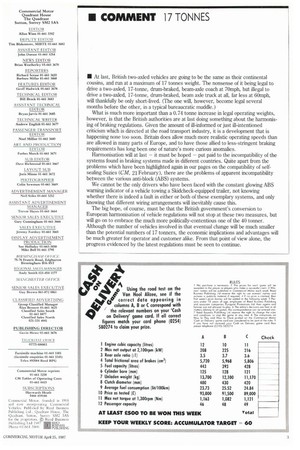• At last, British two-axled vehicles are going to be
Page 5

If you've noticed an error in this article please click here to report it so we can fix it.
the same as their continental cousins, and run at a maximum of 17 tonnes weight. The nonsense of it being legal to drive a two-axled, 17-tonne, drum-braked, beam-axle coach at 70mph, but illegal to drive a two-axled, 17-tonne, drum-braked, beam axle truck at all, far less at 60mph, will thankfully be only short-lived, (The one will, however, become legal several months before the other, in a typical bureaucratic muddle.) What is much more important than a 0.74 tonne increase in legal operating weights, however, is that the British authorities are at last doing something about the harmonising of braking regulations. Given the amount of ill-informed or just ill-intentioned criticism which is directed at the road transport industry, it. is a development that is happening none too soon. Britain does allow much more realistic operating speeds than are allowed in many parts of Europe, and to have those allied to less-stringent braking requirements has long been one of nature's more curious anomalies.
Harmonisation will at last — it must be hoped — put paid to the incompatibility of the systems found in braking systems made in different countries. Quite apart from the problems which have been highlighted again in our pages on the compatibility of selfsealing Suzies (CM, 21 February), there are the problems of apparent incompatibility between the various anti-block (ABS) systems.
We cannot be the only drivers who have been faced with the constant glowing ABS warning indicator of a vehicle towing a Skidcheck-equipped trailer, not knowing whether there is indeed a fault in either or both of these exemplary systems, and only knowing that different wiring arrangements will inevitably cause this.
The big hope, of course, must be that the British government's conversion to European harmonisation of vehicle regulations will not stop at these two measures, but will go on to embrace the much more politically-contentious one of the 40 tonner. Although the number of vehicles involved in that eventual change will be much smaller than the potential numbers of 17 tonners, the economic implications and advantages will be much greater for operator and customer alike. From that point of view alone, the progress evidenced by the latest regulations must be seen to continue.
























































































































